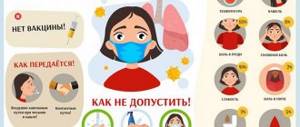Signs of influenza and ARVI
In consultations for parents on the prevention of colds, it is advisable to mention the signs of influenza and ARVI and the differences between them. The ARVI group includes more than 300 respiratory viral infections: adenoviruses, rhinoviruses, respiratory syncytial viruses, etc. Although most of the population calls them colds, they have nothing to do with the cold itself. The fact is that cold weather and seasonal decreases in immunity activate their spread. Therefore, according to statistics, a large proportion of such diseases occur in the cold season.
These infections are called respiratory because their symptoms mostly affect the organs of the respiratory system: pharynx, nose, throat, trachea, bronchi, lungs. The duration of the disease depends on the state of the body of the sick person, the severity of complications, and the type of virus. Influenza is not an acute respiratory viral infection; it is caused by several strains of a different type of virus. A characteristic difference between influenza and respiratory diseases is a significant and prolonged increase in temperature. For 3-5 days it stays at +39º+40º.
Signs of the flu
- Severe headache, manifested mainly in the forehead and temples.
- Muscle and joint pain.
- Pain when moving the eyes.
- Nausea and vomiting.
- Photophobia.
- Decreased blood pressure.
- Severe dry cough and nasal congestion several hours after the first symptoms of infection appear.
Influenza is dangerous due to its complications: laryngitis, tracheitis, pneumonia, damage to the nervous system, cardiovascular failure. In some cases, influenza, complicated by pneumonia and complications of cardiac activity, can be fatal.
Signs of ARVI
- The temperature is at the level of subfebrile values, after a few days (in case of bacterial infection) it can rise to +38º+39º.
- Catarrhal phenomena (hoarseness, cough, runny nose).
- Decreased or complete absence of appetite.
- Lethargy, drowsiness.
Untimely treatment of ARVI can lead to the development of tracheitis, bronchitis, otitis, sinusitis, and larigitis. Both influenza and ARVI are transmitted through household and airborne transmission:
- When a sick person coughs and sneezes.
- Through door handles and in public transport vehicles.
- When using shared toiletries, household items, toys.
- Through coins and banknotes.
It is enough for the virus to reach the mucous membrane of the mouth or eye for infection to occur. In indoor air it retains its damaging effect for 2-9 hours.
Consultation for parents “Beware of the flu!”
MBDOU MO Krasnodar "Kindergarten No. 33"
Consultation for parents
“Watch out for the flu!”
Flu. Symptoms, recommendations for treatment of influenza.
Influenza is an acute infectious disease that primarily affects the upper respiratory tract and causes general intoxication. Influenza is easily transmitted from sick to healthy and affects both adults and children at any time of the year - people are very susceptible to influenza. The latent, or so-called incubation, period for influenza is very short, 1-2 days, so the disease spreads very quickly and intensively. Influenza epidemics recur quite often (every 3-4 years). From time to time they take on enormous proportions and cover the population of the entire globe.
Influenza is caused by viruses; several types are known. The influenza virus, located on the mucous membranes of the nose, mouth and throat of the patient, when sneezing, coughing and talking, enters the air along with droplets of saliva or nasal mucus - infection occurs through airborne droplets, less often through household items.
The disease usually begins suddenly with chills, then the temperature rises to 38-39°, and sometimes up to 40°. Severe headaches and aches throughout the body, especially in the lower back and calves, appear. Malaise and loss of strength are noted, appetite disappears, apathy, drowsiness or, conversely, irritability occur. The face and eyes turn red, the skin becomes hot to the touch, moderately moist. Simultaneously with the rise in temperature or a little later, a runny nose, a feeling of dry mouth, a feeling of rawness in the chest, and a dry cough appear. After 3-5 days, the temperature drops and recovery gradually occurs. For a more or less long time, weakness, weakness, loss of strength, and dizziness remain. Therefore, after the flu, you should not start work without a doctor’s permission; it is especially important to remember this in old age. Influenza is a serious disease, often complicated by pneumonia, inflammation of the frontal sinuses and middle ear, and pleurisy. In some cases, influenza causes complications such as damage to the heart, joints, kidneys, brain and meninges. Parainfluenza diseases occur in the form of acute catarrh of the upper respiratory tract, against which inflammation of the larynx develops (hoarseness, dry, frequent cough). In children aged 1-3 years with significant damage to the larynx, false croup may occur. The temperature is normal or slightly elevated (37-37.3°). When a bacterial infection is associated, para-influenza diseases can be complicated by pneumonia and otitis media. Newborns, infants and young children are especially susceptible to these diseases. Children over 10 years of age and adults get sick less often. Treatment and care are the same as for the flu.
If you have the flu, you should definitely consult a doctor and stay in bed. Food should be nutritious, easily digestible, with a sufficient amount of vitamins, it is advisable to exclude spicy foods. It is useful to drink a lot - hot tea, infusion of dry raspberries, linden blossom, warm milk with Borjomi.
Prevention of influenza and ARVI
Measures to prevent influenza and acute respiratory viral infections in children, included in the consultation for parents:
- During the epidemic season, it is necessary to limit visits to places where large numbers of people gather (shopping centers, cinemas, entertainment events).
- A sick person should be isolated in a separate room, and his room should be regularly wet cleaned with disinfectants;
- Ventilate the premises more often and keep them clean;
- Eat nutritiously, including fresh fruits and vegetables in your diet;
- Do not overwork, follow a sleep and rest schedule, spend more time in the fresh air;
- A few weeks or months before the epidemic season, begin hardening activities and exercise to strengthen the immune system;
- Use personal hygiene items, towels, toys, and treat them daily;
- Rinse your nose, gargle with saline solution 2-3 times a day, be sure to do this after coming home;
- Wash your hands with soap and disinfectant solutions before eating, after visiting places where large numbers of people gather, after caring for a patient with influenza and ARVI;
- Do not touch or rub your mouth and eyes with unwashed hands;
- Pack food from a store or supermarket and thoroughly wash and heat treat it before eating.
Particular care must be taken to monitor hygiene in children of primary preschool age, who, due to their age, cannot do this on their own.
Rospotrebnadzor website https://78rospotrebnadzor.ru/689;
Hotline numbers: 8-812-572-48-37; 8-812-575-81-02;
Telephone number of the unified information center: 8-800-555-49-43.
Influenza,
coronavirus infection and other acute respiratory viral infections (ARVI)
Influenza, coronavirus infection and other acute respiratory viral infections (ARVI) are in first place in the number of people who fall ill each year
Despite constant efforts aimed at combating the pathogens of influenza, coronavirus infection and other acute respiratory viral infections, it is still not possible to defeat them.
Thousands of people die every year from complications of influenza.
This is due to the fact that viruses, primarily influenza viruses and coronaviruses, have the ability to change their structure and a mutated virus can infect a person again. Thus, a person who has had the flu has a good immune barrier, but nevertheless, a new modified virus is able to easily penetrate it, since the body has not yet developed immunity against this type of virus.
For whom is the virus most dangerous?
The infection is especially difficult for children and the elderly; complications that can develop during the disease are very dangerous for these age groups. Children get more seriously ill due to the fact that their immune system has not yet encountered this virus, and for older people, as well as for people with chronic diseases, the virus is dangerous due to a weakened immune system.
At-risk groups
· Children
· People over 60 years old
· People with chronic lung diseases (bronchial asthma, chronic obstructive pulmonary disease)
· People with chronic diseases of the cardiovascular system (congenital heart defects, coronary heart disease, heart failure)
· Pregnant women
· Medical workers
· Workers of public transport, catering establishments
How does infection occur?
The infection is transmitted from a sick person to a healthy person through tiny droplets of saliva or mucus that are released during sneezing, coughing and talking. Contact transmission is also possible.
Symptoms
Depending on the specific type of pathogen, symptoms can vary significantly, both in severity and in combination options.
· Temperature increase
· Chills, general malaise, weakness, headache, muscle pain
Decreased appetite, possible nausea and vomiting
· Conjunctivitis (possibly)
· Diarrhea (possibly)
On average, the illness lasts about 5 days. If the temperature lasts longer, complications may have arisen.
Complications
· Pneumonia
Encephalitis, meningitis
· Complications of pregnancy, development of fetal pathology
Exacerbation of chronic diseases
Treatment of the disease is carried out under the supervision of a doctor, who only after examining the patient prescribes a treatment regimen and gives other recommendations. The sick person must remain in bed, eat well and drink more fluids.
Antibiotics
Taking antibiotics in the first days of illness is a big mistake. Antibiotics are not able to cope with the virus, in addition, they adversely affect the normal microflora. Antibiotics are prescribed only by a doctor, only in case of complications caused by the addition of a bacterial infection. Taking antibacterial drugs to prevent the development of complications is dangerous and useless.
A sick person should stay home and not pose a risk of infecting others.
Prevention
The most effective way to prevent influenza is annual vaccination. The composition of the influenza vaccine changes every year. First of all, it is recommended for those who are at risk to get vaccinated. The optimal time for vaccination is October-November. Vaccination of children against influenza is possible starting from 6 months of age.
Vaccines against most pathogens of acute respiratory viral infections have not been developed.
Universal prevention measures
Wash your hands frequently and thoroughly
· Avoid contact with people who cough
· Adopt a healthy lifestyle (sleep, healthy food, physical activity)
· Drink more fluids
Regularly ventilate and humidify the air in the room you are in
· Be in crowded places less often
· Use a mask when you are in transport or in crowded places
· Avoid hugs, kisses and handshakes during meetings
· Do not touch your face, eyes, nose with unwashed hands.
At the first signs of a viral infection, consult a doctor!
Flu, coronavirus, other acute respiratory viral infections - a mask will help!
During the period of active circulation of pathogens of influenza, coronavirus infection, and other pathogens of acute respiratory viral infections, we remind you of the advisability of using a disposable medical mask as an effective measure to prevent infection and limit the spread of infection.
These viruses are transmitted from person to person primarily through respiratory droplets, through microdroplets of respiratory secretions produced when infected people speak, sneeze or cough.
With the air, these droplets can land on the surface of the mucous membrane of the upper respiratory tract of healthy people who are close to an infected person.
Infection can also occur as a result of direct or indirect contact of a healthy person with the respiratory secretions of an infected person.
Using a disposable medical mask prevents droplets of respiratory secretions, which may contain viruses, from entering the body of a healthy person through the nose and mouth.
· Wear a mask when caring for a family member with symptoms of a viral respiratory illness.
· If you are sick or have symptoms of a viral respiratory illness, wear a mask before approaching other people.
· If you have symptoms of a viral respiratory illness and need to see a doctor, put on a mask ahead of time to protect others in the waiting area.
· Wear a mask when you are in crowded places.
· Use the mask once, reuse of the mask is unacceptable.
· Change the mask every 2-3 hours or more often.
· If the mask becomes wet, it should be replaced with a new one.
· After using the mask, throw it away and wash your hands.
A disposable medical mask, when used correctly, is a reliable and effective method of reducing the risk of infection and preventing the spread of influenza, coronavirus and other ARVI pathogens
Hygiene for influenza, coronavirus infection and other acute respiratory viral infections
What should you do during the period of active circulation of influenza pathogens, coronavirus infection and other pathogens of acute respiratory viral infections (ARVI) in order to prevent your own infection and protect others if you are sick?
The causative agents of all these diseases are highly contagious and are transmitted primarily by airborne droplets.
When a sick person sneezes and coughs, microdroplets of saliva, sputum and respiratory secretions that contain viruses spread into the air around a sick person. Larger droplets settle on surrounding objects and surfaces, while smaller ones remain in the air for a long time and are transported over distances of up to several hundred meters, while viruses retain the ability to infect from several hours to several days. The main measures of hygienic prevention are aimed at preventing contact of healthy people with particles containing viruses from the secretions of a sick person.
Compliance with the following hygiene rules will significantly reduce the risk of infection or further spread of influenza, coronavirus infection and other acute respiratory viral infections.
How not to get infected
· Wash your hands after visiting any public places, transport, touching door handles, money, public office equipment in the workplace, before eating and preparing food. Pay special attention to thoroughly lathering (at least 20 seconds), and then completely drying your hands.
· After returning home from the street, wash your hands and face with soap, rinse your nose with isotonic salt solution.
· Touch your face and eyes only with recently washed hands. If you do not have access to water and soap, use alcohol-based disinfectants to clean your hands. Or use a disposable tissue if you need to touch your eyes or nose
· Wear a disposable medical mask in crowded places and transport. You need to change the mask for a new one every 2-3 hours; you cannot reuse the mask.
· Give preference to smooth hairstyles when you are in crowded places; loose hair, often in contact with the face, increases the risk of infection.
· Avoid close contacts and staying in the same room with people who have visible signs of ARVI (coughing, sneezing, nasal discharge).
· Do not touch door handles, railings, other objects and surfaces in public spaces with bare hands.
· Limit greeting handshakes, kisses and hugs.
· Ventilate the premises more often.
· Do not share towels.
How not to infect others
· Minimize contacts with healthy people (welcome handshakes, kisses).
· If you feel unwell but have to communicate with other people or use public transport, use a disposable mask, being sure to change it for a new one every hour.
· When coughing or sneezing, be sure to cover your mouth, if possible, with a disposable tissue, if not, with your palms or the crook of your elbow.
· Use only personal or disposable tableware.
· Isolate your personal hygiene items from your household: toothbrush, washcloth, towels.
· Carry out wet cleaning of the house daily, including cleaning door handles, switches, control panels of office equipment.
Memo: Prevention of influenza and coronavirus infection
Influenza and coronavirus viruses cause respiratory diseases of varying severity in humans. Symptoms of the disease are similar to those of regular (seasonal) flu. The severity of the disease depends on a number of factors, including the general condition of the body and age.
Predisposed to the disease: the elderly, young children, pregnant women and people suffering from chronic diseases (asthma, diabetes, cardiovascular diseases) and those with weakened immune systems.
RULE 1. WASH YOUR HANDS OFTEN WITH SOAP
Clean and disinfect surfaces using household cleaners.
Hand hygiene is an important measure to prevent the spread of influenza and coronavirus infection. Washing with soap removes viruses. If it is not possible to wash your hands with soap, use alcohol-containing or disinfectant wipes.
Cleaning and regular disinfection of surfaces (tables, door handles, chairs, gadgets, etc.) removes viruses.
RULE 2. KEEP DISTANCE AND ETIQUETTE
Viruses are transmitted from a sick person to a healthy person through airborne droplets (sneezing, coughing), so it is necessary to maintain a distance of at least 1 meter from sick people.
Avoid touching your eyes, nose or mouth with your hands. The influenza virus and coronavirus are spread through these routes.
Wear a mask or use other available protective equipment to reduce the risk of illness.
When coughing or sneezing, cover your mouth and nose with disposable tissues, which should be thrown away after use.
Avoiding unnecessary travel and visiting crowded places can reduce the risk of illness.
RULE 3. LIVE A HEALTHY LIFESTYLE
A healthy lifestyle increases the body's resistance to infection. Maintain a healthy regimen, including adequate sleep, consumption of foods rich in proteins, vitamins and minerals, and physical activity.
RULE 4. PROTECT YOUR RESPIRATORY ORGANS WITH A MEDICAL MASK
Among other means of prevention, wearing masks occupies a special place, thanks to which the spread of the virus is limited.
Medical masks for respiratory protection are used:
- when visiting crowded places, traveling on public transport during a period of increasing incidence of acute respiratory viral infections;
— when caring for patients with acute respiratory viral infections;
— when communicating with persons with signs of acute respiratory viral infection;
— at risks of infection with other airborne infections.
HOW TO WEAR A MASK CORRECTLY?
Masks can have different designs. They can be disposable or can be used repeatedly. There are masks that last 2, 4, 6 hours. The cost of these masks varies due to different impregnations. But you can’t wear the same mask all the time, because you can infect yourself twice. Which side to wear a medical mask inward is not important.
To protect yourself from infection, it is extremely important to wear it correctly: - the mask must be carefully secured, tightly covering the mouth and nose, leaving no gaps;
— try not to touch the surfaces of the mask when removing it; if you touch it, wash your hands thoroughly with soap or alcohol;
- a wet or damp mask should be replaced with a new, dry one; — do not reuse a disposable mask;
— a used disposable mask should be immediately discarded. When caring for a sick person, after ending contact with the sick person, the mask should be removed immediately. After removing the mask, you should immediately and thoroughly wash your hands.
A mask is appropriate if you are in a crowded place, on public transport, or when caring for a patient, but it is not advisable outdoors.
When you are outside, it is good to breathe fresh air and you should not wear a mask.
However, doctors remind that this single measure does not provide complete protection against the disease. In addition to wearing a mask, other preventive measures must be followed. RULE 5. WHAT TO DO IN CASE OF FLU OR CORONAVIRUS INFECTION?
Stay home and consult a doctor immediately. Follow your doctor's orders, stay in bed and drink as much fluid as possible.
WHAT ARE THE SYMPTOMS OF FLU/CORONAVIRUS INFECTION
high body temperature, chills, headache, weakness, nasal congestion, cough, difficulty breathing, muscle pain, conjunctivitis.
In some cases, there may be symptoms of gastrointestinal disorders: nausea, vomiting, diarrhea.
WHAT ARE THE COMPLICATIONS
Among the complications, viral pneumonia leads. Viral pneumonia worsens rapidly, and many patients develop respiratory failure within 24 hours, requiring immediate respiratory support with mechanical ventilation.
Prompt treatment helps to alleviate the severity of the disease.
WHAT TO DO IF SOMEONE IN THE FAMILY HAS SICK WITH THE FLU/CORONAVIRUS INFECTION?
Call a doctor.
Give the patient a separate room in the house. If this is not possible, maintain a distance of at least 1 meter from the patient. Limit contact between the sick person and loved ones to a minimum, especially children, the elderly and people suffering from chronic diseases. Ventilate the room frequently.
Keep clean, wash and disinfect surfaces as often as possible with household detergents.
Wash your hands often with soap and water.
When caring for a patient, cover your mouth and nose with a mask or other protective equipment (handkerchief, scarf, etc.). Only one family member should care for the patient.







